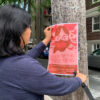
This article was originally posted on the website of the James McGregor Stewart Society. Re-posted with permission.
If there is any truth to the article Unraveling the Colonialist Myths of Nova Scotia in Smithsonian Magazine, it is that Nova Scotia has been a palimpsest, written on by colonialists, loyalists, government, even by 20th century Buddhists and anti-Trumpists.
The fantasies are as contagious as the Delta variant; invoking the label ‘world class’ in what Tim Bousquet of The Examiner called “a sad need for outside validation, a craving for attention from the wider world coupled perhaps paradoxically with a suspicion of actual Come From Aways.” Now the mantra is “Equity, Diversity and Inclusion”
Reality intrudes, and events like Boat Harbour, abuse of children, the deforestation, the careless disposal of toxic waste, Africville, the murder of 20 people and the undoing of cult leader Trungpa bring disillusion. Romantics return to Toronto. ‘Restorative Justice’ is invoked to hide the evidence. Apologies abound.
In 2016, along came Bill 59; what the government thought of as a simple promise to make Nova Scotia Equitable, Inclusive and Diverse. Not as easy as it appeared……..
People with disabilities were outraged, they wanted self determination and rights, not condescension and vague promises. A series of hearings led to considerable improvement.
As a result, public sector bodies are charged with developing accessibility plans.
- Develop Nova Scotia, Events East, Innovacorp, Nova Scotia Business Inc. and Tourism Nova Scotia are seeking Nova Scotians with lived and learned accessibility experience to join a new Crown Accessibility Advisory Committee.
- Working together with members from each corporation, the Crown Accessibility Advisory Committee will work to identify, prevent and eliminate barriers to people with disabilities in their programs, services, initiatives and facilities.
The five corporations have 50 directors. I don’t know a thing about them, but their short biographies lead me to this summary:
- 22 women
- 28 men
- 44 white
- 3 indigenous
- 1 African Nova Scotian
- 2 of unguessable ethnicity
- 0 People with (visible) disabilities
The 50 are appointed through something called Agencies, Boards and Commissions, a creature of the Executive Council, which advertises thusly:
Employment Equity Policy: The Government of Nova Scotia has an employment equity policy and we encourage people from diverse communities to apply. Applicants are invited to self-identify to help us increase diversity on our ABCs.
Moving Toward Equity. Employment Equity and Diversity in the Nova Scotia Public Service, 2019–2020
lists the following statistics:
| Designated Group | Nova Scotia’sLabour Force | Nova Scotia Public Service |
| Indigenous People | 5.6% | 3.6% |
| Visible Minority (including Black) | 2.4% | 8.6% |
| Persons with Disabilities (ages 15-64) | 9.9% | 11.8% |
| Women | 49.1% | 54.0% |
Relying on self reporting is dubious and the lack of criteria leads to miscategorization. What does ‘Racially Visible’ mean? Does your depression make you disabled?
Recognizing shortcomings, the Executive Council put together a new plan. It promises progress and measurement.
Here is the key sentence:
There is growing evidence that ties diversity and inclusion to better business practices. As an employer with a focus on providing quality services to our changing demographic, the Nova Scotia Public Service needs to ensure that we have the best knowledge and understanding of what Nova Scotians need.
But it contains no timeline – only more resonant language and vague promises. Certainly there is no recruitment plan. Reference is made to adopting ‘Global Diversity and Inclusion Benchmarks’. There are no progress reports.
The Crown Accessibility Advisory Committee meets the requirements of Bill 59, but does not give people a seat at the table. It is decisions and projects that can profit immensely from diversity.
The chair of Nova Scotia Business and CEO of Credit Union Atlantic needs to sit at the same table with a person with a Registered Disability Savings Plan and learn the potential of the $250,000.000 the province is busy throwing away. She needs to get that quarter of a billion invested in the province and address homelessness.
The chair of Tourism Nova Scotia needs to learn firsthand about accessible tourism. She’ll learn the difference between a roll-in shower and a tub with a chair. She’ll figure out why tourists expect accessible rooms to be saved for those who need them. Maybe she’ll even figure out why people like to wash their hands before eating.
The chair of Innovacorp, needs to hear from a rural person with a mobility disability about the virtues of home monitoring through cellular technology and how it could save millions of dollars in personal visits while giving better service.
The chair of Develop Nova Scotia may have learned a lot from their misadventure at the Stubborn Goat. But still the flagship property in Lunenburg, the Bluenose itself, has a “No Disabled Allowed” step.
The chair of Events East, needs to sit with a person, a Nova Scotian, with an intellectual disability and explain why minimum wage laws don’t apply.
That’s what diversity of ideas means. That’s why we need a seat at the table, not a place at the take-out window.
See also: Government abandoned earlier commitments to community living supports, new report charges
Check out our new community calendar!
With a special thanks to our generous donors who make publication of the Nova Scotia Advocate possible.
Subscribe to the Nova Scotia Advocate weekly digest and never miss an article again. It’s free!




My brother Claredon Robicheau was one of the authors of Bill 59 . I am gravatationaly challenged. In 1999 I was divorced. I have been looking for subsidized housing for over 20 years in the Meteghan area in Digby County. So I have been warehouse in a seniors facility for years .